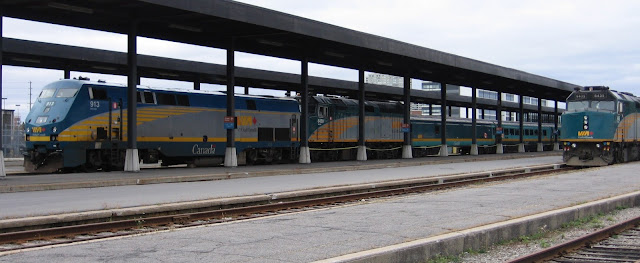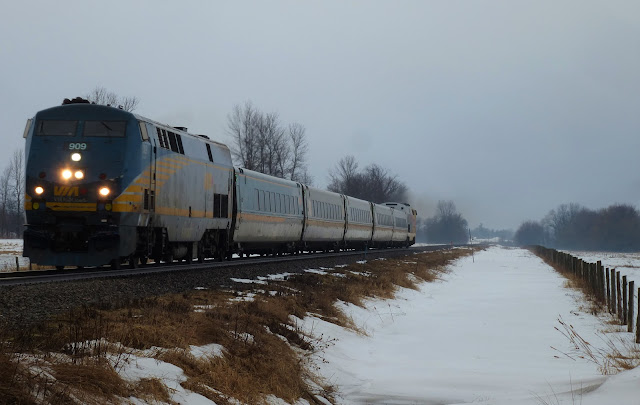Those who have been here know there is a small hill next to the tracks, close to where Bedell Road crosses the tracks. Sadly, the weeds on the hill are making photos tough. But, closer to the crossing, there is a clear section next to the bad order track that offers a fairly decent vantage point where you can capture an eastbound train.
I should mention that I had initially set up on the hill and was planning to try and get in front of the weeds on the edge of the hill, in order to capture a westbound freight. But, for the first time, I heard the sound of an engine horn coming from the east, which forced me to scramble to the clearing near the tracks. The only disadvantage to this spot is that is in not elevated.
Anyway, I set up and could hear the eastbound freight charging toward the crossing at quite a clip. I’m not sure what the speed limit would be on this stretch of the tracks, but I am assuming this train was travelling at about 70-80 km/h. Some experts tell me the limit is 65 mph which seems about right.
But what I found interesting was that, while there was a double stack container behind the power, there was a short string of autoracks, which gave way to a long string of containers. I don’t pretend to know why trains are made up the way they are, but I did find these outliers interesting in an otherwise all-intermodal train.
In this shot, I think I might have caught a refrigerated container unit (UASC marks on the side). At least that was what it looked like. This was the only container on the train that had what seemed like an air conditioning unit. Someone who is more knowledgeable can correct me, if I'm off the mark.
I know most railfans don’t like shooting intermodal consists, but I always like getting a shot of a string of colourful containers in a long line. This train had no Canadian Tire containers to shoot, so I contented myself with a few of these multicoloured images.
Another thing I found interesting was that this train had barely a spot of graffiti on it. I know that well cars are usually not the canvass of choice, but they do often bear frequent tags of the “artists” who deface trains. This consist had almost none. I think it might have been because much of this train was made up of brand new well cars. Mostly, they were these shiny yellow TTX wells.
Here’s a question for the experts out there. I occasionally see these tanks in well cars. This train had a number of them. What do these tanks usually carry? I wonder why a liquid cargo would be carried in these tanks on well cars and not in a dedicated tank car. It might be because the liquid is from overseas, which would necessitate being handled in an international shipping container. Just a guess. Does any out there know?
This was a long train. I had to work around a lot of bushes to get a decent going away shot of the end of the train. Here it is. A great meet for me at my favourite spot.




















